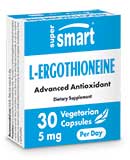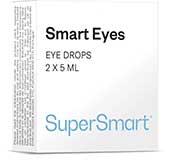20-07-2015
Specific supplements that protect against cataracts
 Along with the eye diseases AMD and glaucoma, cataracts need to be taken seriously. In addition to foods containing nutrients that provide daily protection, it’s important to take advantage of state-of-the-art supplements that specifically target the lens.
Along with the eye diseases AMD and glaucoma, cataracts need to be taken seriously. In addition to foods containing nutrients that provide daily protection, it’s important to take advantage of state-of-the-art supplements that specifically target the lens.
The first thing to do is review your diet, making sure you include foods every day, or at least several times a week, that provide nutrients essential for maintaining the physiological health of your eyes:
-
- Red-to-purple fruits such as blueberries, blackcurrants and red berries, fresh or frozen, to provide flavonoids and in particular, anthocyanosides, which are highly effective at protecting against free radical damage to the eyes and which also have anti-glare properties.
- Dark green vegetables, especially spinach, kale, watercress, Swiss chard, rocket and broccoli, as well as herbs such as basil and parsley. They contain lutein and zeaxanthin, two xanthophyll carotenoids often found together in foods which effectively act as sun filters and also significantly improve the eyes’ reaction to glare.
- Liver or other offal for its rich vitamin A content, essential for good night vision, and/or orange-coloured seasonal fruits and vegetables such as carrots and carrot juice, sweet potatoes, squash and red peppers for beta-carotene, a precursor to vitamin A.
- Rose shrimp or salmon to provide astaxanthin.
- And finally, almonds, sunflower seeds, wheat germ and hazelnuts, for valuable vitamin E.
So which supplements can help prevent or stabilise cataracts?
For a better understanding of cataracts, it is necessary to visualise the lens, which is located behind the iris. Completely transparent, the lens can gradually become partially or entirely opaque - and irreversibly so. In the case of senile cataracts, this happens from the age of 65-70 though cataracts can also develop at the same time as long-sightedness, at around 45 years old.This opacification is linked to oxidative stress in the lens and to changes in the way nutrients are transported from the aqueous humour to the lens interior which consists of fragile proteins particularly sensitive to oxidative processes.
There are a number of risk factors that predispose towards cataracts. These include direct and prolonged exposure to the sun’s ultraviolet rays, smoking, poorly-controlled diabetes, a diet low in fruits and vegetables and taking certain corticosteroid and anti-depressant drugs.
Since cataracts are primarily the result of free radical attack on the lens, it is essential to supplement with substances that have potent anti-radical activity.
Lutein and zeaxanthin are two xanthophyll carotenoids which the body cannot produce. Several studies have shown that daily supplementation with these two specific antioxidants, at doses of 10mg of lutein and 2-3g of zeaxanthin, may be associated with a decreased risk of cataract.
Taxifolin, or dihydroquercetin, is a flavonoid extracted from Siberian larch. Its potent antioxidant capacity has been highlighted in almost 600 studies including research on type 2 diabetics which suggests it can prevent cataract formation by inhibiting activity of an enzyme in the lens. A dose of 60mg a day, spread over three meals, is sufficient to stabilise or prevent the disease.
Astaxanthin, whether from the algae Haematococcus pluvialis or from Krill oil, the tiny crustaceans found in cold Antarctic waters, is a powerful antioxidant carotenoid that protects the lens from the harmful effects of free radicals. The generally recommended dose is 3-4mg a day, to be taken with a meal containing some fat to enhance its bioavailability.
Other eye health nutrients, available in complex form, are also essential if your daily intake of colourful fruits and vegetables is less than ideal. These complexes frequently combine berry extracts (blackcurrants, cranberries, blueberries, strawberries, elderberries, raspberries …) rich in protective anthocyanins and anthocyanosides.
Reduced glutathione is also crucial for minimising free radical attack on the lens. Taking reduced glutathione protects lens proteins, membranes and enzymes from oxidative damage caused by peroxide radicals. Taking 500mg/day of reduced L-glutathione for at least three months is therefore recommended, or 1.8g of N-acetyl-cysteine in order to provide the cysteine essential for the synthesis of L-glutathione.
L-carnosine also has a role to play in protecting against this disease. It combats glycation or the ‘caramelisation’ of proteins in the lens. Animal studies have demonstrated that a 500mg dose, taken three times a day with meals, is effective at treating and slowing the progress of senile cataracts. It may therefore prove particularly beneficial for diabetics who regularly have high blood glucose levels.
The final substance, which can be taken alongside those above, is L-ergothioneine, an amino acid derived from L-histidine which includes a sulphur atom. All the research conducted on this completely innocuous substance has noted its remarkable ability to protect the lens against oxidative stress. Certain vitamins also offer benefits for cataract prevention, the most effective of which are:
-
- vitamin C, because it is 30 times more concentrated in the lens than in the blood. In studies, it has been shown that taking 500-1000mg a day of this exceptional antioxidant lowers the risk of developing cataracts1. Vitamin C also enables L-glutathione to be recycled and maintained in its reduced form.
- There is also an inverse relation between cataract incidence and vitamin E status. A dose of around 400IU a day of alpha-tocopherol may be able to reduce the degree and magnitude of the disease’s development due to the significant antioxidant potency this fat-soluble vitamin.
- FinallyVitamin B6, in the form of Pyridoxamine, one of the vitamin’s three natural forms, works by inhibiting the formation of advanced glycation end-products in the lens by stimulating the activity of aldose reductase and by reacting with AGE precursors.
References :
Jacques PF1, Taylor A, Hankinson SE, Willett WC, Mahnken B, Lee Y, Vaid K, Lahav M. Long-term vitamin C supplement use and prevalence of early age-related lens opacities. Am J Clin Nutr. 1997 Oct;66(4):911-6.
Order the nutrients mentioned in this article
 Bilberry Extract
Bilberry ExtractA bilberry extract for improving microcirculation and reducing visual fatigue
www.supersmart.com Macula Plus
Macula PlusImproved formulation
Boosts visual and macular protection
Maximal bioavailability and stability
 OptiVision
OptiVisionNew, more complete and potent formulation providing advanced, synergistic protection for visual function
www.supersmart.com L-Ergothioneine 5 mg
L-Ergothioneine 5 mgAn unparalleled, new generation antioxidant with multiple properties
www.supersmart.comFurther reading
10-10-2016
In India, turmeric is used to treat a wide variety of ailments including gastrointestinal problems, inflammation, headaches, infections and colds. It is turmeric’s curcuminoid content,...
Read more08-05-2019
Though it is well-established that red and orange fruits and vegetables such as carrots, sweet potatoes and tomatoes reduce the risk of age-related macular degeneration...
Read more26-04-2017
Have you heard about sea buckthorn berries? Since the beginning of the 2000s, interest in these small orange berries has been growing steadily, accompanied by...
Read more© 1997-2024 Fondation pour le Libre Choix
All rights reserved
All rights reserved
Free
Thank you for visiting our site. Before you go
REGISTER WITHClub SuperSmart
And take advantage
of exclusive benefits:
of exclusive benefits:
- Free: our weekly science-based newsletter "Nutranews"
- Special offers for club members only


























